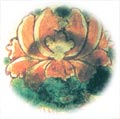|
����Color used for decoration on the porcelain occurred in the late
period of Xi Jin Dynasty at first. Then simple designs composed of
brown speckles could be found on some celadon in South China. In Sui
dynasty, the hair, cap, frown, eyes and the cloths on the porcelain
has been painted by black decoration. Underglaze brown glaze was then
produced in Changsha ware in Tang dynasty. While Overglaze decoration
originated from Song dynasty. Moreover, the blue and white, underglaze
red and gold enamels just occurred in Jin and Yuan dynasty.
����Various kinds of decorative porcelain occurred in succession in
Xuande and Chenghua period of Ming dynasty. For example, clobbering
red decorative on the blue and white porcelain made during the years
of Xuande and doucai contrasting colors made during Chenghua period.
The blue decorative and kingfisher blue were created in Jingdezhen
in Qing dynasty. The famille rose possessing unique decoration style
was formed gradually in the years of Kangxi and reached the summit
in Yongzheng and Qianlong period. Down to the middle period of Qing
dynasty, foreign color was began to be used because of the introduction
of decorative arts from western countries.
Brown color decoration
|
����Brown color decoration is a kind of pigment which uses iron
as its color generation. It was first seen in the later part
of Xijin and widely used from Dongjin to early Nan dynasty.
It has two decoration styles: one is that different designs
composed of dots were painted at the rim of the mouth and
the shoulder. Another is to paint the designs in long-stripped
shape. The length and the thickness of the line should be
in accordance with the surface of the porcelain. Commonly,
the lines on the lids are thin and short, while long and thick
on the abdomen.
|
 |
|
|
Black decoration

|
����Onglaze
black decoration was mainly used to draw the outline
and the artery of branches and leaves. The main
staining elements of our traditional onglaze black
decoration are iron, manganese, cobalt and copper.
It has two main characteristics: firstly, saltpeter
cannot be added when compounding the black decoration
pigments. As a result, the content of potassium
and natrium is low. Secondly, the leather pastern
is used as mastic gum, which makes the lose rate
of firing for black decoration pigments reaches
twenty percent.
|
TOP
|
|
Blue
colors
���TThe traditional onglaze blue
colors developed from cobalt blue lead glaze, which
was used on sancai since Tang dynasty. Natural asbolane
is the coloring agent for blue glaze and blue colors.
There are different amount of iron, manganese and
other elements in the asbolane; they are the traditional
coloring agent for onglaze blue colors. Sometimes
a little amount of copper was added in blue colors
so as to slightly adjust the tinge of it.
|
 |
TOP
|
|
Gold
enamels
����The decoration of gold enamels on the porcelain
may appear splendid and increase their artistic
value. Such decoration was invented in Tang dynasty.
Gilding and appliqu��ing products were already found
in the tombs during this period. The porcelain of
gold enamels fired in Ding kiln, Jian kiln and the
gold enamels on the porcelain of Yuan, Ming dynasty
still used gold foil. It was not until Qing dynasty
that gold foil was replaced by gold powder. From
the aspects of techniques, it was gilding that substitute
appliqu��ing. In late Qing dynasty, liquid gold was
invented by a German and then introduced to China.
As a result, gold foil and gold powder was gradually
eliminated. Liquid gold has the advantage of low
consumption and simple usage so as to become the
main pigment of gold enamels.
|
|
TOP
|
Song
additive colors
����In Song dynasty, a new technique was used in decorating
porcelain. That is to dip the pigments with brush
and then decorate simple veins on the surface of
the glaze. After that, the porcelain will be decoration
baked in the kiln under 800 centigrade so as to
make the pigments and the glaze closely connected.
That is why it is called "song additive colors".
Such kinds of porcelain are mainly about paintings
of plants and birds in red and green on white-glazed
bowls and plates. So they are also called "song
red and green colors".
|

|
����That the painting on the surface of the
porcelain with brush symbolizes a new stage. From then on,
incised decoration, printing decoration and appliqu�� decoration
were eliminated and replaced by decoration.
TOP
|

|
Fahua
color
����Fahua color flourished in Puzhou
and Zezhou in Shanxi province then imitated in different
places. The producing of fahua is to paint veins
on the surface with prominent and embossed decoration
in colors of blue, green and purple. Fahua products
made in Jingdezhen are mainly about people, plants
and birds in shape of bottle and jar. Some of them
are used for decoration while others are used as
offerings. The body of fahua products are pure and
the shape is elegant, especially the chrysanthemum-eared
vase. Fahua was first used in Yuan dynasty and flourished
in Ming dynasty, while little was fired after Qianlong
period of Qing dynasty.
|
TOP
|
|
|
��
|
|